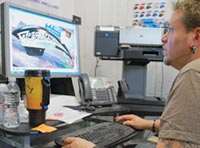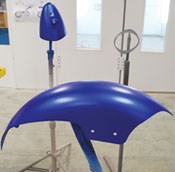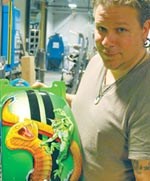Passion for Paint
A look at Orange County Choppers' in-house finishing process
#masking
Since the debut of the American Chopper television series in 2003, fans of the show have watched Paul Teutul Sr., his sons Paul Jr. and Mike, and the crew at Orange County Choppers (OCC; Newburgh, NY) build dozens of over-the-top custom bikes for companies and individuals.
What viewers largely have not seen is manufacturing of OCC's "production" motorcycles, which account for the bulk of the business founded by Teutul Sr. in 1999. The company employs approximately 70 people-more than 30 in production, with three of those currently dedicated to paint-and recently moved to a new facility totaling nearly 100,000 ft2to enable expansion of its production motorcycle operations.
Featured Content
According to operations manager Henry Kroll, OCC manufactures about 150 production bikes per year, with price tags starting at less than $30,000 and heading north from there depending on the level of customization the buyer wants. Of course, even OCC's production bikes are far more involved in terms of paint and customization than mass-produced machines. "In terms of customization, anything goes-chrome, paint, special fabrication-anything's possible," Kroll says.
Lead painter Robb Ortel, who handles airbrush duties and is responsible for OCC's overall paint process, puts it another way: "For a lot of people, the paint is the first thing you see on a bike and the last thing you remember," he says. "We're trying to step it up a notch and make the production bikes more custom-not just one or two colors, but some airbrushing and graphics.
"We're the best of the best, and we want to show that. What we can do is only limited by the customer's imagination and budget."
In-Sourcing Rationale
According to Kroll, paint had long been a bottleneck in OCC's manufacturing process. "Our timelines are tight," he explains. "We're pretty demanding on turnaround times. Especially on the TV bikes, parts change all the time. Sometimes they change even after they've been painted, and they have to be re-done on short notice."
Improved control over delivery and quality are two of the main reasons the company wanted to bring painting in-house, a transition that began in a previous building and accelerated when OCC moved to its new digs last spring. Now, all motorcycles, whether for the TV show or for production, are painted by Ortel and his crew.
"Bringing the paint process in-house has improved quality all the way through the process," Kroll says. "For example, if something is prepped incorrectly, we can see it and get it fixed right way.
"But the biggest thing is efficiency," he continues. "Everyone is working, everything is moving through the shop and we are saving money."
Ortel, who has been painting motorcycles for 21 years, was working as a subcontractor for OCC before the company approached him about moving in-house. For him, it was not a tough decision. "We bounced some ideas back and forth and I came aboard in June 2008," he says. "It's been a very positive experience, because this company's approach is to hire good people and then allow them the freedom to do the job they were hired to do."
Paint Process
One of the big drawbacks of outsourcing paint operations was apparent from Ortel's first day on the job. "When I first came here they had about a dozen bikes backed up-ready to go, but missing the painted tins," he says.
So, one of Ortel's main tasks is to keep paint from becoming a production botteleneck. To do that, OCC combines careful planning with a pretreatment and paint process that's kept as simple as possible.
Pretreatment consists of sandblasting of the "tins"-tanks, fenders and other steel components-to remove any contaminants and prep the surface for paint. This is followed by any needed bodywork, which may range from grinding to application of Bondo and even fiberglass lay-up in some cases.
"Production bikes are usually easier because they use standard parts," Ortel explains. "Bodywork needed for those is actually pretty minimal. But custom bikes might require more extensive bodywork, and for those we may use Bondo or fiberglass and then Bondo on top of that. All that work is done in-house in the paint shop.
"So we get the tins, sandblast them, do any needed bodywork, prime them and apply the base coat," Ortel continues. "Once the base coat is dry enough to handle, the parts come to me. I do the layouts needed for any airbrushing or other graphics, spray the graphics, and then it's back to the paint team for clear coat and buffing before the bike is built."
To lay out airbrushed graphics, Ortel starts by placing a scale on the part and snapping a digital photo. He dumps the photo into his PC, sets the scale and starts laying out the needed artwork. "Usually the artwork is a combination of freehand stencils and freehand airbrushing," he explains.
Once layout is finished, Ortel sizes the design to the proper scale and makes a pattern by sending the information to a stencil cutter that cuts vinyl sheet to match the pattern. The sheet cut can then be laid on the part to be painted. "I use stencils for a nice sharp line," Ortel says. "It's like taping, but obviously a lot faster. Another advantage, as opposed to laying a mask on the part and then drawing and cutting it, is that I'm not cutting into the base paint."
During PF's visit Ortel was working on designs for a chopper for the Jon & Kate Plus Ei8ht TV show. Other TV bikes in the shop at varying stages of production included one for Chesapeake Energy that was undergoing final build and blue base-coated tins for a "World of Warcraft" motorcycle that will be one of two choppers produced for the popular online role-playing game.
All OCC's paint materials are high-solids, solvent-based urethanes similar to those used in automotive finishing. Base coats are used at the paint:reducer ratio recommended by the supplier. For airbrush work, Ortel custom mixes paint to thin it enough to flow through the airbrush. "For fine detail work, sometimes it might even be 80% reducer to 20% paint," he says.
"The base paint dries to the point where it can be handled in about an hour," Ortel says. "At that point it can be taped, and I can start laying out my graphics and painting. The layout and airbrush process might take a couple of hours or it sometimes might take up to a week, depending on how involved the graphics are."
None of the paint requires curing at temperature, but if parts are needed quickly temperature in the paint booth can be increased to 140-150°:F for 30 min. "At that point parts are ready to be buffed and polished and sent to the shop," Ortel explains.
Speaking of the paint booth, it was supplied by Col-Met Engineered Finishing Solutions Spray Booths. The main booth is a custom side/down-draft unit built to fit into the relatively low space-ceiling height is 12 ft-allotted for paint operations at OCC. The booth was run off at Col-Met's facility in Rockwall, TX earlier this year, when footage of Ortel putting finishing touches on a Col-Met chopper was shot for an American Chopper episode that aired in April.
Col-Met also supplied a smaller booth with a carbon overspray filter where Ortel can do his airbrushing and other detail work. "It runs as efficiently as a full-size booth, it's just smaller," Ortel says. "The air circulates through charcoal filters and back through the booth, so odor is eliminated. The lighting is great, and air circulation pulls overspray away from me and into the filters."
Airbrushes and some guns were supplied by Anest Iwata USA, Inc. (West Chester, OH). Ortel explains that he was comfortable with the company's airbrushes, and worked with Iwata to bring in some gravity-feed guns.
Since each bike is essentially a custom job, paint cycle times vary tremendously. A relatively simple paint job might be done in three days from bodywork to mounting. Custom jobs can take a week or more.
In-House Benefits
According to both Ortel and Kroll, having the paint process for all OCC products in-house has produced multiple benefits for the company.
"It really improves communication," Ortel says. "It enables us to bounce ideas back and forth, and it helps everyone know what's going on, what's next and what the deadlines are.
"The two big issues with outsourcing the paint were delivery and lack of communications. This way everyone's on the same page, it's much more under control, and the final outcome is what everyone is anticipating."
In-house paint has also enabled OCC to step up deliveries of production motorcycles. Kroll says a typical wait for a production OCC chopper might be six weeks from order to delivery. "When you think about it, six weeks to get something that's one-of-a-kind, that you'll never see anyone else with anything remotely like it, is quite a feat," he says.
"Deadlines are always an issue, but since I've been here we haven't missed a single one," Ortel concludes. "So it's a win-win situation to have paint in-house-the shop is happy because we're able to produce on time, and customers are happy because they're getting their bikes on time."
RELATED CONTENT
-
Quality Finishing: Don’t Starve Your Spray Gun for Air!
Tips to Avoid Pressure Drop in Air Spraying
-
Improving Transfer Efficiencies in Coating Operations
There are many methods for addressing electrostatic grounding in metal painting processes, and Tim Ulshafer from Mueller Electric says the best method for your process is a simple and worthwhile exercise.
-
Pretreatment for Painting
Better adhesion, enhanced corrosion and blister resistance, and reduced coating-part interactions make pretreatment a must.





















